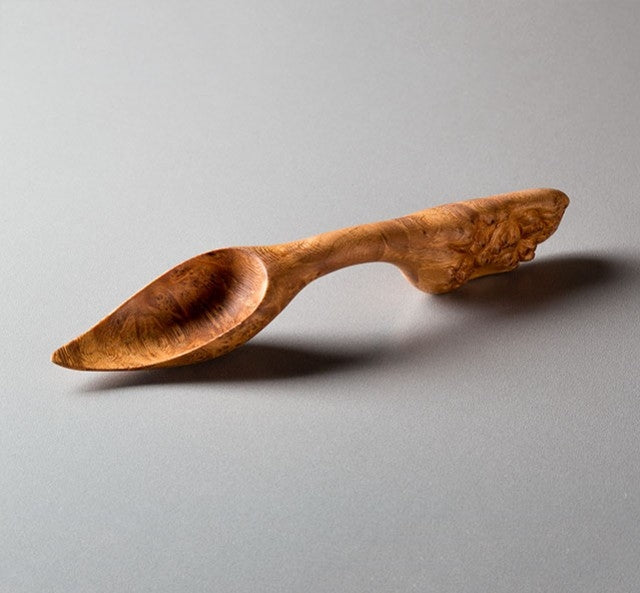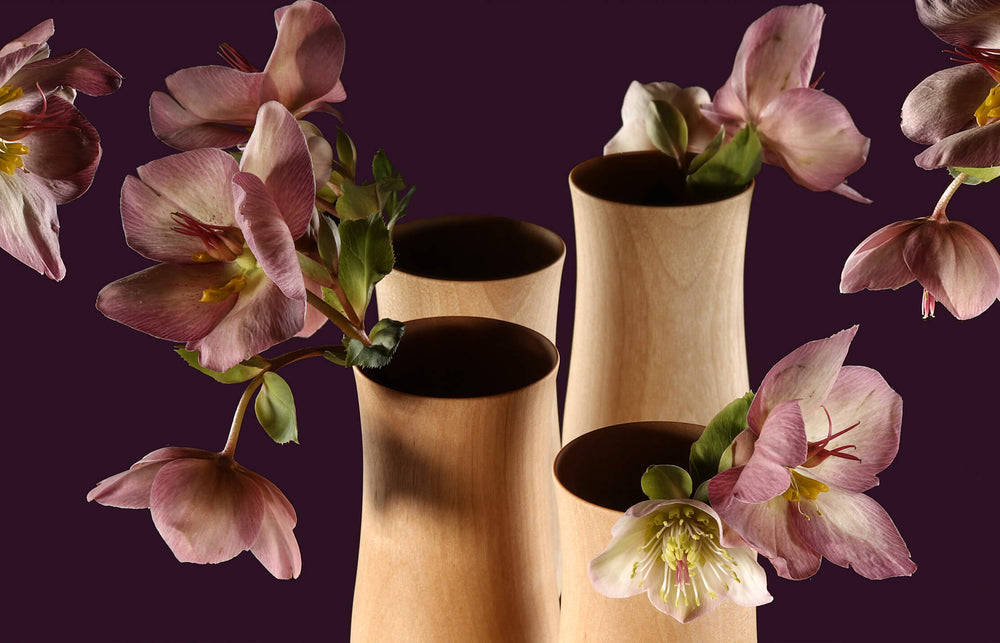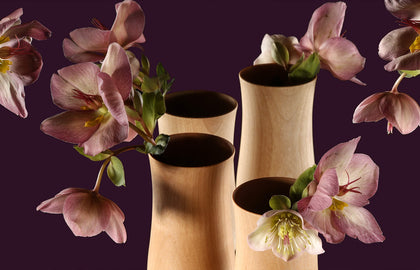
Interview with Terry Widner of Spoontaneous - Part Two
Are there specific types of wood that you most enjoying working with? Are certain woods better suited to functional vs. dysfunctional spoons? Would you say that different woods have different personalities?
Yes, there are some really great carving woods, and like you suggest sometimes the function (or lack of it) determines the desirability of the wood.
Closed-grained woods make the best functional spoons, as the more coarse woods could be uncomfortable to use and prone to harbor bacteria in the open pores. Yet, some of those coarse-grained woods can be used to outstanding effect in the nonfunctional pieces.
My two (current) favorite woods for functional spoons are serviceberry wood (Amelanchier) and Surinam cherry (Eugenia uniflora). All of the serviceberry I've used came from Ohio, although a variety of the tree grows in most states.
 Functional spoons made from serviceberry
Functional spoons made from serviceberry
The wood works a bit like cherry, but there is just something about it that keeps me looking for more. Every spoon I've carved from it seems to turn out better than I thought. The wood oftentimes has little brown flecks that add visual interest.
The Surinam cherry is not really a cherry at all. The small edible fruit looks like little red pumpkins hanging from the branches. Here in South Florida the small tree is considered an invasive species. A friend occasionally brings me branches when he clears his garden.
This wood has incredible tensile strength, especially considering how fast it grows. The cured wood is dense and hard and finishes out silky smooth. All from a weed tree! But I can't really claim enjoying working with this wood the most. A bit hard for that—but worth the effort.
 Surinam cherry
Surinam cherry
A few woods that I really enjoy carving are boxwood (known for its tight grain), lilac (carves like butter and you only have to threaten it with sandpaper and it will finish out baby-butt smooth), horse chestnut, black locust burl, cherry burl, and York gum burl (Australia).
Some woods are more difficult to carve but can achieve a really nice effect in some of the more decorative pieces: macadamia wood (Hawaii), elm burl, bloodwood, ebony— well, the list goes on.
 Ms. Mac - macadamia wood | Antelope - bloodwood & ebony
Ms. Mac - macadamia wood | Antelope - bloodwood & ebony
Can you share some of the techniques that allow you to create such intricate and complex shapes? Which tools are integral to the spoon making process?
I would say the majority of spoon carvers use traditional tools like knives, axes, and gouges. These tools are most effective on “green,” or fresh cut, wood. Working with these tools is the traditional method of making functional spoons.
I prefer using rotary tools, a sort of drill-like motor spinning a variety of bits and burrs that cut, shape, and sand the wood. This method is much better for dry wood, which tends to be much harder than green wood. I can also use the rotary tools on fresh-cut wood, but the rotating burrs tend to clog often.
If I had to rely on traditional tools or traditional carving skills, I'd probably get two spoons made in a year's time. I'm slow enough using power tools, but so far I still have all my fingers. I'm not sure I could say the same thing if I were to use blades.
I've been using the same Foredom carving motor for about 30 years. I've had to replace the motor brushes a few times, as well as the flexible shaft. I have it plugged into a variable speed foot pedal, which I use to control the speed. The pedal has broken several times over the years and is mostly held together with epoxy. It doesn't operate very smoothly anymore, but I've sort of adjusted to it.
 Square Knot
Square Knot
Do you have a personal favorite?
I've asked myself that same question a few times. So, I've thought about it. The answer always depended on the criteria I used for choosing.
If I consider it in terms of aesthetics only, it is difficult to choose one spoon over all of them. There are a few that I really like the look of, maybe because of the lines or the color and grain of the wood.
I'm partial to some of the spoons that seem humorous to me, even if the shape of the spoon might not have achieved the effect I hoped for. I like seeing the humor present itself.
And then I consider which ones have been most popular, but this never works because usually the ones I like the most get the least attention. And some of the ones that get more attention are the ones that I don't like so much.
Having said all that, I do have a favorite. It is a simple spoon carved from a dead branch of a particular beech tree. When my daughter was a toddler, we would visit Bernheim Forest (a beautiful arboretum in Kentucky), and in the beech grove there is a beautiful specimen of a weeping beech tree.
We could walk to the back of the tree, separate the branches that grew all the way to the ground, and enter inside the domed “room.” We would have picnics and the such while the dense canopy held the mosquitoes at bay, and with the branches being so close together it was an easy climb for my daughter, even at that age.
We called it our Enchanted Tree.
Ten or twelve years later I was visiting my daughter in Kentucky and we drove down to Bernheim to visit “our” tree. While still magnificent, the tree had apparently suffered some wind damage. Under the tree were several broken branches lying on the ground.
The park has a posted policy that no wood, rocks, or leaves are to be removed, so I was prepared to honor that, but as we walked back to the parking area a park ranger was making his rounds. I flagged him down and explained that I was a spoon carver and was it possible to have a piece of the broken branches.
He considered it and said that if the branches were already on the ground he'd have no problem with it. I asked him to hold on for a second while I ran over to the car and brought back one of my Spoontaneous posters for him to have. He had just made my day.
So the Enchanted Spoon is my favorite spoon—and by a country mile.
 Enchanted Spoon - weeping beech wood
Enchanted Spoon - weeping beech wood
We love that you accompany each spoon with a story, whether about the origin of the material, the name, or the process. Do you have a favorite story?
I'm not sure that I have a favorite spoon story, but the one that comes to mind is one that never even happened. One of the men I work with had visited my Spoontaneous website, and he commented that he liked reading about how the spoons came about.
Each day on our drive to the work site we would drive around one of those looped entrance ramps to the Turnpike. In the middle was a fairly large retaining pond that had ducks and an occasional egret or heron. Many of these small lakes also harbor alligators, which are quite common down here.
One morning as we drove around the ramp, I could swear I saw an alligator head sticking out of the water near the shoreline. I pointed it out to my coworker to see if he could make it out (as I was driving I had to pay attention to the curve in the road, and the truth is my eyeballs don't work so well at a distance). He couldn't say for sure either, but he agreed that the shape, color, and size made it likely.
So the next couple of mornings as we drove by we would both strain our eyes trying to make it out. After a few days we decided it had to just be a log because the dang thing never moved.
My coworker suggested that we retrieve the wood so I could make a spoon and be able to tell the alligator story as to how that spoon came about. I never got the wood and never made the spoon, but I still have the story.
Spoon making is not your only art form. How have your other artistic interests impacted your spoons?
Sometimes quite directly. For many years I had a project in mind (and in my sketchbook) for a wall piece. It was designed to be a woman's torso in laminated cardboard with the “female parts” missing. I was planning to use stencils to spray “Void Where Prohibited” in red paint.
Never quite got around to completing that project, but the same idea got expressed in a spoon using the same title.
 Void Where Prohibited
Void Where Prohibited
A similar thing happened with the Y the Long Face spoon. It was originally conceived as a large Y-shaped slab of wood for hanging on the wall. But I guess when you are a spoon maker many of the ideas tend to get fleshed out there.
 Y the Long Face
Y the Long Face
Do you use a wooden spoon in the kitchen?
Embarrassing enough, I only have one wooden spoon in our kitchen, mostly due to mercenary reasons. Sell spoons...pay shop rent...keep wife.
The one wooden spoon I do have is there because I tried carving a spoon using the pith of the branch as center of the spoon. Every woodworker knows this is where the wood is most prone to splitting. Even I knew this, but I kept wondering if it were true. It is.
But this little wooden spoon with a split is as silky smooth as it was 3 years ago, which is one reason why serviceberry is my favorite wood for carving functional spoons.
In your opinion, what are the characteristics of a good functional wooden spoon?
The spoon should feel strong and comfortable in the hand. Little skinny handles, especially the store-bought round ones, can awkwardly rotate in your hand. This is what is meant by “losing your grip.”
The shape of the spoon bowl should match the intended use. A deep and round bowl for soups and the such, and a more shallow spoon bowl for stirring.
As mentioned earlier, using a wood with a tight, closed grain is important. Even then, the spoon should be soaked in water after carving to raise the wood grain. As the wood dries, the wood fibers will raise up making the surface fuzzy, or even rough. This roughness should be sanded smooth and the wetting/drying process repeated with finer grits of sandpaper. The spoon is then ready for a protective oil and/or wax finish.
In my opinion, those are the qualities that make for a good functional wooden spoon. But add to this a bit of decoration or using a particularly beautiful piece of wood and you might just end up with an “heirloom quality” spoon, to be used and enjoyed before it passes hands.
Don't miss PART ONE of our interview with Terry Widner.
Shop Terry's work Here.

















